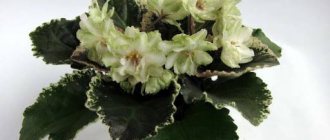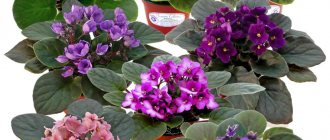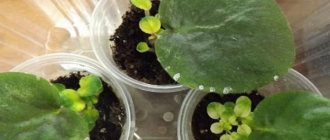Alina Volskaya began by pollinating industrial Saintpaulias with varietal violets.
The result of this work was the emergence of new varieties, differing:
- cap flowering;
- straight sockets;
- minimum number of stepchildren;
- good viability.
In 2009, she did not set herself the goal of developing new varietal Saintpaulias, she just wanted to slightly diversify the range of industrial violets.
Today, a very large number of varietal Saintpaulias with the prefix “Alain” are known .
For the last 2-3 years, Alina has been working to completely change the color and shape of violets. Saintpaulias that have flowers of different colors, different shapes of leaves and rosettes are selected for parent pairs.
a series of red-flowered and fantasy violets were obtained . Due to the fact that fantasy violets are the most unstable, working with them takes longer.
Description of violet Spring Rose
The progenitor of the variety is the American breeder Paul Sorano. As a result of painstaking work, a violet was obtained with white, densely double flowers resembling roses with a diameter of 4 cm. The edges of the petals have a greenish tint, which weakens during the flowering process and subsequently disappears completely. As you can see in the photo, the Spring Rose violet is distinguished by bouquet flowering, which lasts for 6-8 months if the basic requirements of the culture are met.
The Spring Rose violet bush is compact, standard size, with light green, hairy leaves with a carved edge and a light back. As the plant matures, they acquire a darker shade.
The plant blooms at the age of 10-12 months, forming a large number of greenish buds rising on strong peduncles above the foliage. The lower edge of the leaves begins to hang down as they grow, hugging the pot. Violet forms a shallow root system that develops quickly when the plant's requirements are met. When growing this variety, you must adhere to certain maintenance rules, which guarantees long and abundant flowering.
Violet, violet, I know you!
Viola tricolor is the official name of violet. Belongs to the group of herbaceous plants. In the wild, the plant is found more often in ditches, ravines and meadows. Prefers neutral or acidic soil.
You can recognize the tricolor violet by its small bushes - description:
- height - no more than 30 cm;
- leaves are round in shape with a sharp tip, collected in a rosette at the base of the bush;
- peduncles - rise from the rosette;
- flowers are small, 1–2.5 cm in size;
- the color palette is not so rich, white, blue, yellow and purple appear more often;
- Active flowering time is April-September.
30 cm
height of a tricolor violet bush
Any type of tricolor violet can have one of 5 types of petals:
- the two upper petals are purple, blue or dark purple;
- two lateral ones are sky blue or lighter;
- the lower one is bright or soft yellow with black stripes; petals of pastel shades are less common.
The plant can be one- or two-year-old, but on my site there are also “old-timers” that have lost a little of their decorative value, but still bloom.
Watering and humidity
Spring Rose violet does not tolerate waterlogging of the soil, which leads to rotting of the roots. Therefore, watering must be carried out when the top layer of soil dries, avoiding moisture getting on the foliage. Therefore, it is best to use a watering can with a long narrow spout.
The optimal humidity level is 50-60%. However, you cannot spray the leaves additionally, as this leads to their deformation and rotting of the petioles. Therefore, in order to increase the humidity to the required level, it is recommended to place additional containers of water next to the pot, which will increase the area of evaporation.
About the benefits of violets
Tricolor violet is a storehouse of anthocyanins, carotenoids, ascorbic acid, saponins, polysaccharides, and tannins. That is why it is actively used in folk medicine.
Violet decoction saves from many diseases
For colds and inflammatory diseases of the gastrointestinal tract:
- pour a tablespoon of chopped dry grass into 200 ml of boiling water;
- leave for 40 minutes, wrapped in a warm towel;
- take 100 ml three times a day.
In the treatment of psoriasis:
- violet and celandine herbs (20 g each) pour 0.5 liters of boiling water;
- cover with a lid and leave for an hour;
- Take the strained infusion 3 times a day, 2 tbsp. l.
You need to be careful with medicinal plants, violet is no exception. It is contraindicated for gastritis and peptic ulcers, hepatitis and glomerulonephritis, during pregnancy and for children under 12 years of age.
Transplanting a plant
In the process of growing Spring Rose violets, it will be necessary to annually transfer the plant into a new pot, which guarantees the full development of the rosette and long-term flowering.
The main signs indicating the need for a transplant:
- slow growth;
- root shoots appeared from the drainage holes;
- a thickened bare trunk has formed at the base;
- long absence of flowering;
- the bush looks weakened.
For the plant, you need to choose a pot 1-1.5 cm wider in diameter than the previous one. It is recommended to replant using the transshipment method, without exposing the root, but only filling the resulting voids with earth. But if the root system is rotten, it is necessary to cut it back to healthy tissue and remove as much old soil as possible.
For violets, you need to prepare special soil, which can be purchased at any specialty store. But it can also be prepared at home.
To do this you will need to mix the following components:
- peat - 30%;
- coconut substrate - 20%;
- turf soil - 30%;
- river sand - 10%;
- perlite - 10%.
This composition fully meets the needs of the violet and will allow the bush to fully develop and grow.
Subsequently, the transplantation procedure is carried out in several stages.
- Place a layer of drainage on the bottom of the pot 1 cm high.
- Sprinkle nutrient soil on top.
- Take out the plant and shake off the old soil a little.
- Remove the bottom row of leaves.
- Place the violet in the center and water a little.
- Fill the voids with prepared soil and compact lightly.
After replanting, the lower leaves should touch the edge of the pot. Place the violet in a shaded place for 2-3 days to adapt, and then move it to a window and water it a little. If the soil settles slightly, it must be added.
The procedure can be carried out in early spring, as well as during the summer and early autumn. It is not recommended to do this in winter since the Spring Rose violet is in the dormant stage, so all growth processes in the plant slow down.
Growing violets correctly
Planting and caring for violets does not require much effort or knowledge.
Choosing a location . The beauty of violets is that they look equally beautiful anywhere. I grew them in a container on the balcony, in a pot on the windowsill and in the garden flowerbed, and sometimes just like that, somewhere near the border.
Violet loves light. The more sunlight there is in the area, the larger the flowers. But light has one drawback - it shortens the flowering time. In light partial shade, violets can bloom for up to 5 months, but the flowers themselves will be small and not so bright.
Another important factor is soil. Yes, violet can grow in poor soil, but if you choose a large-flowered variety, don’t expect a miracle; the flowers will become small. In addition, rich humus soil significantly extends flowering time.
Growing method . I propagated violets by seeds and cuttings. I liked the first option better. But! Please note that hybrid varieties, such as Wittrock violet, are best propagated either from store-bought seeds or cuttings. This will guarantee that the plant will inherit its “parental” traits (color, flower size).
The first question is how to collect the seeds? When ripe, the seed pod shoots out, scattering the seeds. To prevent this from happening, tie the heads with gauze, then the seeds will remain inside. Store the seeds in a dark linen bag that does not allow light to pass through!
Sowing seeds for seedlings
- The seedling or seed method can be implemented both in open ground and in a greenhouse/box. The first shoots appear after 2 weeks. After another 3 years, when the leaves appeared, I planted the seedlings into cups. If you plan to plant directly into the ground in rows, maintain a distance of 20–25 cm so that the violet is not crowded when it grows. You should start replanting into a flower garden when the violet is already blooming.
In order for the plant to undergo transplantation painlessly, you need to plant violets in the flower garden when they bloom.
When to plant violets?
- If you want to see the first flower in the spring, sow the viola in the summer (July) of the previous year. In the fall, the sprouts will be given time to grow and get stronger, but not to bloom.
- In summer, violets bloom, sown in pots in February-March. In this case, the dive is carried out in mid-April, and landing in open ground in May.
- Autumn violets will be pleasing to the eye if you sow them in late April - early May.
Video: growing violets from seeds.
- Propagation by cuttings . Shoots with 2-3 nodes are suitable for cuttings. I carried out the cutting procedure itself at the beginning of summer. To do this, I prepared beds in a shaded but not dark place.
The cuttings are taken in the summer, when the plant is blooming.
The cuttings were planted to a depth of 1 cm in moist soil, first sprayed, then watered daily. Rooting occurs after 4 weeks. With this method, rainbow flowers will appear in summer and autumn.
When planting later, the cuttings will overwinter at the cutting site; in this case, they are transplanted in the spring. Planting viola before winter has one significant advantage - flowering will be abundant and long-lasting.
Video: cuttings method of growing violets.
Possible problems
With minimal care, the Spring Rose violet is able to fully bloom and develop, but sometimes there are situations when, without the help of a grower, it can die. Therefore, it is important to monitor the general condition of the plant and promptly respond to negative changes, as they are a sign of exposure to pests or diseases.
Typical problems with violets:
| Name | Cause | Characteristic signs | Elimination methods |
| Root rot | Regular overflow, use of cold water, reduced temperature | The plant looks dejected, the leaves lose turgor and become soft, but do not change color | The plant can be saved only at the first signs of disease. It should be replanted in new soil and watered with Maxim or Previkur. |
| Powdery mildew | Excess nitrogen in the soil, keeping it close to the affected plant, transplanting into contaminated soil | White coating on leaves and petioles | Spray the plant with any of these preparations “Topaz”, “Skor”, “Fitosporin” |
| Rust | Lack of light, non-compliance with temperature conditions | Brown spots on leaves that gradually increase in size | Spray and water the plant with “Skor” or “Fitosporin” |
| Spider mite | Dry air, low humidity, high temperature | Slow growth, dejected appearance, leaves in the center do not develop, the edge of the leaf blade turns down | Treat twice with Actellik or Fitoverm with a break of 7 days |
| Thrips | Close keeping with a bouquet of garden flowers or with an already affected plant | Pollen spills out of the flowers, dirty spots appear on the flowers and white spots on the leaves. | Spray the violet with “Actellik” or “Actocyte”, repeat the procedure every 10 days until the pest is completely destroyed |
With proper care, this variety of violet can delight with its abundant flowering over a long period of time. But if the maintenance requirements are ignored, the plant will not be able to fully develop.
Caring for violets: 2 rules
| Rule 1. Watering After transplanting into open ground, seedlings need abundant watering. In the future, watering is carried out with a frequency of 2 times a week. | |
| Rule 2. Fertilizer From fertilizers, choose ammonium nitrate and superphosphate. I used a complex mineral fertilizer with phosphorus, potassium and nitrogen. Pay attention to the soil, if it is sandy and dry, be sure to add humus and compost Fertilizer is applied twice a year - during the flowering period and before the buds ripen. |
Contents in room culture
For the “NK-Fragolino” violet, to maintain its elegant decorative appearance and maintain health at the proper level, the classical rules of care :
- North-facing windows require lighting, and southern-facing windows require shading. Ideal placement on eastern and western window sills;
- It is better to water in medium doses, after slightly drying the upper part of the soil;
- It is best to apply fertilizing when there is a visible need;
- Violet lighting should be natural, diffuse spectrum, for a long time during the day;
- The temperature should be adjusted within the optimal range for the variety: +20 + 24°C;
- Humidity must be slightly increased using any methods other than direct spraying of the violet itself;
This violet is easy to care for. - The substrate for Saintpaulia should be rich in nutrients, well aerated, and with sufficient water permeability. Drainage will only improve the properties of the soil;
- When transplanting, it is better to choose a gentle transshipment method.
Reviews
Boris Leonidovich. “ I am a violet grower with zero experience: I retired and decided to take up a wonderful hobby. At the exhibition, I was struck by the name of the violet “NK Fragolino” - strawberry (I know a little Italian). I bought a leaf and studied all the rules for growing variegated violets. Maybe I was lucky as a beginner - it turned out to be a nice bush. But the flowering was disappointing, only three faded flowers. On the advice of a neighbor, I moved the violet to a warm room, and the second flowering took place according to the promised scenario. I’m happy with my “strawberry”, I will breed other varieties.”
Larisa Vladimirovna. “ I have never purchased variegated violets for my collection; I was afraid that I would not be able to handle their maintenance. But the strawberry “NK Fragolino” won my heart with its wonderful pink coral color, elongated petals and thick clusters of tone along the edge.
I bought a baby and it turned out that there is nothing wrong with variegated leaves. The main thing is to find a temperature balance so that the leaves are edged (lower degrees) and the flowers bloom in bright colors (a higher temperature is needed).
Now the variety is my favorite. I advise all my friends to take my leaves for propagation.”
RS-Favorite
The delicate variegated variety was obtained by breeder Svetlana Nikolaevna Repkina from Lugansk. Flower growers became acquainted with violets in 2015.
Species affiliation
A photo of the violet RS-Lubimaya gives a complete picture of its appearance. The plant belongs to the standard type , as it forms a not very large rosette. Due to the color of the leaves, the variety belongs to the variegated group, and according to the color of the corollas, it belongs to the border type.
Description
Saintpaulia is distinguished by its smooth, filled rosette . The leaf blades have a rich shade of green with a slight frame of white specks and spots. The petioles are strong and slightly elongated.
Refers to varieties with a bouquet type of flowering. Very large buds are densely collected in the center of the leaf rosette.
Due to the small number of petals, the corollas belong to the semi-double variety, but the wavy tips of the petals give the flowers additional volume.
The color of the violet is close to a fantasy version : the center of the flower is occupied by a white star, the petals are painted in shades of pink, their tips are shaded by an edging of lilac-cherry dots, and bluish splashes are visible over the entire surface of the flower.
Features of growth and flowering
The “Lyubimaya” variety is distinguished by its very early first flowering - newly rooted children are already capable of forming buds. Each flowering is characterized by an abundance of blossoming corollas.
The violet spends a very short period of time resting after flowering and is again ready to form buds even without replanting. Blooms for a long time.
The splendor and size of flowers increases with each new flowering. The variegated color of leaf blades with the age of the plant is also capable of increasing brightness and volume.
The nuances of keeping indoor culture
Violet “Favorite” is a fairly easy variety to care for . The only difficulty can be presented by its variegated leaf feature.
When fertilizing, it is important to control the percentage of nitrogen component in fertilizers . Since nitrogen helps to increase chlorophyll, with a large volume of it, leaf variegation may disappear.
ATTENTION! To maintain the decorative appearance of the rosette, it is better to keep the variety in cool conditions (up to +18 +20°C) - the white edging becomes brighter.
Reviews
Anna Nikolaevna. “I want to share my experience with flower growers who have the “Favorite” variety in their collections. For additional winter lighting, place the lamps at a considerable distance from the violet leaves. For me and my friend, from the bright light, the edge of the leaves almost disappeared and turned into a pink thread. After the lamps were removed, the variegation returned. Be careful!"
Sofia. “I really like the delicate variety “Favorite”. I received a leaf at an exhibition, it took root quickly, formed a small rosette and has already formed buds. I'm looking forward to early flowering."











